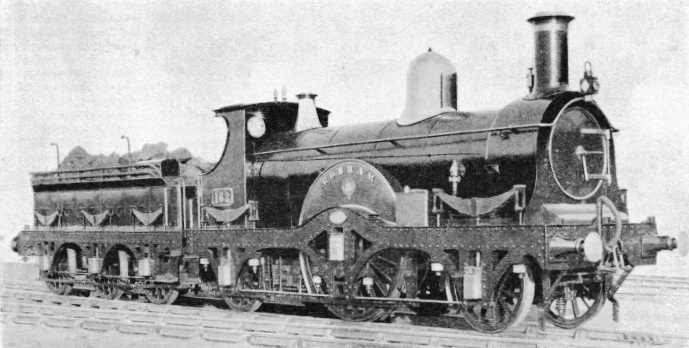Progress During the Past Fifty Years
DESIGN AND INVENTION - 15
THE “COBHAM”, one of the ten single-driving-wheel engines designed by William Dean and built for the GWR between 1878-79. The cylinders of the “Cobham” measured 18 in by 24 in; driving wheels had a diameter of 7 ft, the total heating surface was 1,214¼ sq ft, and boiler pressure 140 lb. These “singles” worked principally on express services between London and Wolverhampton.
THE steady improvement in locomotive design that had been proceeding since the inception of railways to the year 1880 continued to the end of the nineteenth century. Many types of engine incorporated features of design such as are now in general use, and weights showed a marked tendency to increase as more and more was demanded of the locomotive to meet the growing needs of the railways. During the period 1880-90 there was a revival in the use of the single-driving wheel engine, particularly after the steam sanding apparatus was introduced in 1886. The blowing of sand by means of a steam jet under the driving wheels greatly increased the adhesion, and enabled the locomotives to start and haul heavier loads. The story of the famous “singles” is told in the chapter “Some Famous Singles”.
Express engines of the 2-4-0 type continued to be built. On the London and North Western Railway the “Precedent” class was increased by ninety-six new locomotives with 6 ft 9 in coupled driving wheels and a boiler pressure of 160 lb per sq in.
The North Eastern Railway built in 1885 some 2-4-0 engines of the “Tennant” class, with 7 ft 1 in driving wheels and 18 in by 24 in cylinders. James Holden built a series of 110 engines of the 2-4-0 type for the Great Eastern Railway. These locomotives had 18 in by 24 in cylinders and 7 ft driving wheels.
Another type of engine in general use at that time was the 4-4-0. The 4-4-0’s are described in the chapter “A Famous Locomotive Type”. Notable examples were the Midland engines of 1885-87, with 18 in by 24 in cylinders and 7 ft driving wheels.
The 4-4-0 engines designed by James Stirling for the South Eastern Railway in 1884 had 19 in by 24 in cylinders. At the end of 1889, 117 of these engines had been constructed, and many of them, re-built, ran for over fifty years. In 1882, William Stroudley introduced his famous “Gladstone” class of 0-4-2 express passenger engines, some of which gave half a century of service. Thirty-six of these fine engines were built by 1891. The cylinders were 18¼ in by 26 in; coupled wheels were 6 ft 6 in diameter, and the weight, without tender, was 38¾ tons.
Locomotives of the 0-4-2 type were also built for the London and South Western Railway by Wm. Adams. Ninety of the Adams engines were built between 1887 and 1895. Cylinders were 18 in by 26 in, and the coupled wheels were 6 ft 1 in diameter.
Other engines designed by Adams included the 4-4-2 outside-cylinder tank locomotives used on the LSWR for local traffic. These had 17½ in by 24 in cylinders, 5 ft 7 in driving wheels, and weighed 54 tons. Seventy-one of these tank engines were built between 1882 and 1885.
Large numbers of 2-4-2 tank engines, with a radial axle at either end, were built by T. W. Worsdell for the Great Eastern Railway in 1884-85. Cylinders were 18 in. by 24 in, and the driving wheels were 5 ft 4 in diameter. The weight of the engines was 51 tons 18 cwt, and the tanks held 1,200 gallons of water. These engines were the first to use cast steel centres for the driving wheels.
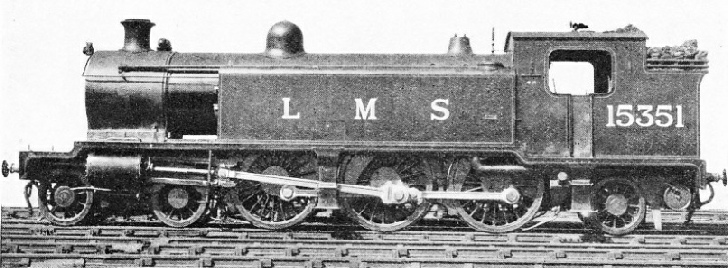
SUPERHEATED LMS TANK LOCOMOTIVE, formerly owned by the Caledonian Railway. Cylinders measure 19 in by 26 in, diameter of coupled wheels is 5 ft 9 in, boiler pressure 170 lb per sq in, total heating surface, including superheater, 1,716 sq ft, and total weight in working order 91 tons 13 cwt. Tractive effort at 85 per cent boiler pressure is 20,704 lb.
Large tank engines of this type were also designed by Sir John Aspinall in 1889, and were built for the Lancashire and Yorkshire Railway for about twenty years. The cylinders of these engines were 18 in diameter by 26 in stroke, and the coupled wheels were 5 ft 7 in diameter.
It was in the ‘eighties that considerable attention began to be paid to the compounding of locomotives. A full description of the various methods employed to make the most use of the steam available from the boiler and so secure fuel economy, is given in the chapter on “The Evolution of Compounds”. On French railways also compounding made its appearance. In 1885 A. G. de Glehn introduced his four-cylinder compound locomotive, with two inside high-pressure cylinders driving one axle, and two outside low-pressure cylinders driving another axle.
Improvements continued to be made in engine details. A vortex blast pipe was introduced by Wm. Adams in 1885 to increase the draught through the lower tubes of the boiler, and for the same purpose “petticoat” tubes at the base of the chimney were adopted in Great Britain in 1888. Steel castings for frame stays and brackets were used to replace those of
wrought iron by F. W. Webb in 1880.
Other improvements of the ‘eighties included the use of ‘I’ section coupling rods, the substitution of metallic packing for the hemp formerly used for piston and valve rods, air-operated water pick-up scoops and more commodious locomotive cabs.
Train speeds in 1884 reached a maximum of about seventy-five miles an hour, and the normal loads on the fast expresses were not generally in excess of 150 tons. In 1894 the last of the 2-2-2 engines had been built for the Great Northern Railway, and many of these ran for twenty years. This type of locomotive had ceased to exist on British railways by the end of 1914. A large number of 4-2-2 “singles” were built, however, between 1890 and 1900, for the Great Western, Midland, Great Eastern, North Eastern, Great Northern, and Great Central Railways. The Great Northern “singles” designed by H. A. Ivatt in 1900-1 were the last of this type to be built for a British railway.

BUILT FOR THE CALEDONIAN RAILWAY, this 4-4-0 locomotive is now owned by the LMS. Cylinders measure 20½ in by 26 in, and the diameter of the driving wheels is 6 ft 6 in. Grate area is 20.7 sq ft, boiler pressure is 180 lb per sq in, and the total weight of the engine alone is 61¼ tons.
An interesting comparison may be drawn between Mr. Ivatt’s singles of 1900 and his famous “Atlantic” locomotives of 1910, which after twenty-five years were still hauling main line trains in 1935. A similar comparison can also be made between the Great Western singles of 1894 and the famous “City” class of locomotives on that railway. Both of these engines were designed by W. Dean, the latter type having the 4-4-0 wheel arrangement. A feature of the 4-4-0 express passenger engines of this period was the placing of frames and cylinders between the wheels.
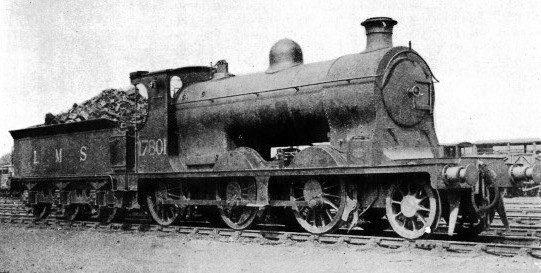
A “MOGUL” BUILT IN 1912 for freight service by the Caledonian Railway. This 2-6-0 engine has cylinders 19½ in by 26 in, the diameter of the coupled wheels is 5 ft, and the total wheel base is 24 ft. The grate areas is 20½ sq ft, and the boiler pressure 160 lb per sq in. The weight of the engine is 54¼ tons, and the tender 37¼ tons. The latter can carry 3,000 gallons of water and 4½ tons of coal.
In 1890-92 some 4-4-0’s were built by W. Adams for the London and South Western Railway with outside cylinders 19 in by 26 in, and 7 ft 1 in driving wheels. Others of this class had 6 ft 7 in drivers. A fine working sectional model of one of these graceful locomotives may be seen in the Science Museum, South Kensington.
Sir John Aspinall’s 4-4-0 engines of 1891-94 on the Lancashire and Yorkshire Railway had inside cylinders 18 in by 26 in and 7 ft 3 in coupled wheels. These were the only two-cylinder engines of the type to be fitted with Joy’s valve gear. W. Worsdell’s North Eastern “1620” class engines of 1892-93 had inside cylinders, and outside valve chests with valves operated through rocking shafts, an unusual arrangement. In 1896-97 two engines of this class were built with 20 in by
26 in cylinders and 7 ft 7 in driving wheels, the largest coupled wheels ever used in Great Britain. The North Eastern “R” class of 4-4-0’s were fitted with piston valves, and used steam at a pressure of 200 lb. Sixty of these engines were built between 1899 and 1907.
In 1896 J. F. Mclntosh introduced the famous “Dunalastair” class of 4-4-0 engines with 18¼ in by 26 in cylinders, 6 ft 6 in driving wheels, and boilers having a diameter of 4 ft 8 in - an unusual size at that date. These were followed a year later by the “766” class, also with 6 ft 6 in driving wheels, but having cylinders 19 in by 26 in. These engines were provided with double bogie tenders carrying 4,125 gallons of water and seven tons of coal.
In 1897 an important step forward in British locomotive design was marked by the introduction of engines with four cylinders, all taking high-pressure steam from the boiler. On the Glasgow and South Western Railway, James Manson’s 4-4-0 locomotive had two outside cylinders 12½ in by 24 in and inside cylinders 14½ in by 26 in. Driving wheels were 6 ft 9½ in in diameter, and the inside cylinders were fitted with Howe-Stephenson link motion, which also drove the outside valves by rocking levers. This locomotive was rebuilt by R. H. Whitelegg in 1923 with a larger boiler, which was superheated, outside cylinders 14 in by 24 in, and inside cylinders 14 in by 26 in. It received the name “Lord Glenarthur”.
The London and North Western four-cylinder simple designed by F. W. Webb, is referred to in the chapter “A Famous Locomotive Type”.
Firebox Water Tubes
The London and South Western’s 4-4-0 engine, No. 720, built by D. Drumrnond, had firebox water tubes and two pairs of uncoupled driving wheels. The front pair was driven by two inside and the rear pair by two outside cylinders. The cylinders were 16½ in (afterwards reduced to 15 in) by 26 in stroke, and the driving wheels were 6 ft 7 in diameter. The boiler heat- ing surface was 1,664 sq ft, and the engine weighed 54 tons 11 cwt. Five more locomotives of this type were built in 1901. No. 720 was rebuilt with a larger boiler in 1905.
In 1898 the first 4-4-2 or “Atlantic” engines were introduced in Great Britain by H. A. Ivatt on the Great Northern Railway. These fine engines, forerunners of the type on other British railways, had outside cylinders 18¾ in by 24 in, with coupled wheels 6 ft 7½ in diameter. The boilers had 1,442 sq ft heating surface, and the steam pressure was 175 lb per sq in. The weight of these “Atlantics”, without tender, was 58 tons. The first inside cylinder 4-4-2’s were built by Sir J. Aspinall for
the Lancashire and Yorkshire Railway in 1899-1902. Forty of these engines were constructed with 19 in by 26 in cylinders and coupled wheels 7 ft 3 in diameter. The boilers had a heating surface of 2,053 sq ft and a grate area of 26 sq ft.
The first ten British 4-6-0 express passenger engines were built by W. Worsdell for the North Eastern Railway in 1899-1900. These engines had 20 in by 26 in cylinders, driving wheels 6 ft 1 in diameter, heating surface of 1,768 sq ft, and steam pressure at 200 lb per sq in. Some years before, however, in 1894, a number of 4-6-0 goods engines designed by D. Jones had been built by Sharp, Stewart and Co for the Highland Railway. These locomotives weighed 56 tons and had outside cylinders 20 in by 26 in, driving 5 ft 3 in coupled wheels.
Many powerful goods engines with the 0-8-0 wheel arrangement were built in the early ‘nineties for working mineral trains. The first inside-cylinder 0-8-0 was built by F. W. Webb for the London and North Western Railway in 1892. Webb’s three-cylinder and four-cylinder compound goods locomotives are referred to in the chapter “The Evolution of Compounds”. In 1900 some inside-cylinder 0-8-0’s were built for the Lancashire and Yorkshire Railway; they had 20 in by 26 in cylinders, 4 ft 6 in wheels, and Joy’s valve gear. Contemporary with these engines were the 0-8-0’s of H. A. Ivatt on the Great Northern Railway, with inside cylinders 19¾ in by 26 in and 4 ft 8 in wheels. The boiler heating surface was 1,439 sq ft, with steam pressure at 175 lb. The weight of the engines was 54 tons 12 cwt.
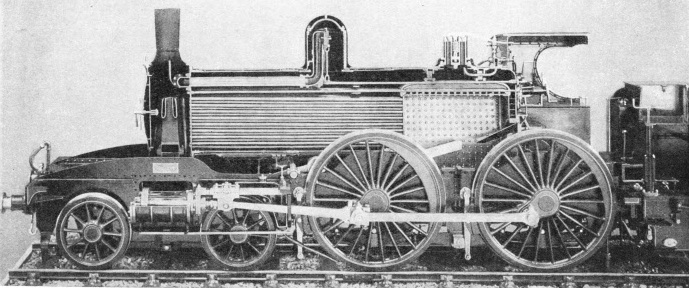
A SECTIONAL VIEW of W. Adams’ London and South Western express locomotive. The engine was claimed in its time (1890-92) to be one of the most powerful express engines then operating on the lines of Great Britain. The total weight of the engines win working order was 48 tons 13½ cwt.
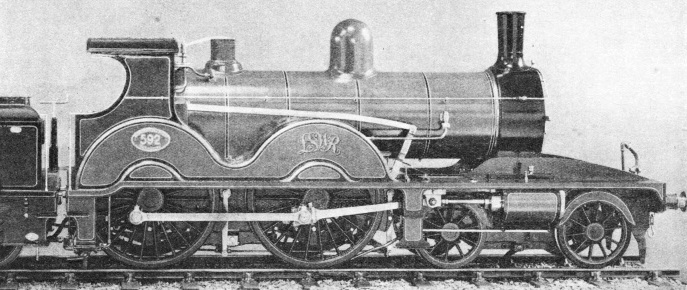
AN EXPRESS LOCOMOTIVE OF 1892, designed by W. Adams for the London and South Western Railway. This 4-4-0 engine had cylinders 19 in by 26 in, diameter of driving wheels was 7 ft 1 in, total heating surface was 1367.7 sq ft, grate area 18 sq ft, and the boiler had a pressure of 175 lb per sq in.
During the last ten years of the nineteenth century many important modifications were made in locomotive design that were destined to remain standard practice for over forty years. The principal development was the adoption, in 1891, of the Belpaire, square-topped firebox for locomotive boilers on the Manchester, Sheffield and Lincolnshire (later Great Central)
Railway.
In 1897 the Belpaire firebox was adopted by W. Dean on the Great Western Railway and by Sir John Aspinall on the Lancashire and Yorkshire Railway It is now used extensively on most railways.
About the same time (1897) that the water-tube firebox was fitted by D. Drummond to his London and South Western engines, F. W. Webb fitted double chimneys arranged in one casing to some of the London and North Western locomotives. One chimney was carried down through a horizontal partition in the smoke-box to draw the gases through the lower fire tubes. The other chimney served the top tubes. The idea was abandoned after two years’ service, but it makes an interesting comparison with the double chimneys of modern designs.
Valves and valve-gear underwent a change during the ‘nineties; ordinary D slide valves were replaced by the piston and “balanced” type of slide valve. A balanced slide valve is one on which the full force of the steam is not permitted to press, thus reducing friction and the amount of power required to move it. Walschaerts valve gear was fitted by Beyer Peacock and Co to inside-cylinder engines for Northern Ireland in 1890; but the gear was not adopted for outside cylinders in Great Britain until a later date, except for a solitary tank engine acquired in 1881 by the Swindon, Marlborough and Andover Railway.
The Schmidt Superheater
From 1900 onwards locomotives with three and four high-pressure cylinders were developed, and their use was extended on all the principal British railways.
The 4-4-0 type of express passenger engine was built by the leading railway companies. Between 1900 and 1910 the 4-6-0 type of engine began to supersede the four-coupled locomotive for heavy main-line passenger work. An important development was the introduction of high-temperature superheating of steam supply to locomotive cylinders. The fire-tube superheater was patented by Dr. Wilhelm Schmidt in 1900, and was first used on British railways in 1906, having been fitted to a Great Western 4-6-0 passenger engine and two goods engines on the Lancashire and Yorkshire Railway. The principle has since been generally adopted, Briefly, the Schmidt superheater comprises a number of steel pipes that pass backwards from the smoke-box through enlarged fire-tubes, returning to the smoke-box in the form of a long U. Steam from the boiler passes through these tubes on the way to the cylinders, and is so heated to a high temperature. Superheaters in use at the present time differ from the Schmidt apparatus only in constructional details; the operating principle remains the same.
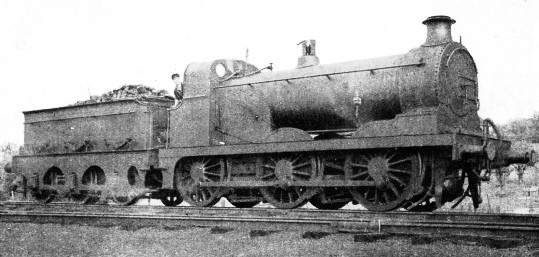
ON THE EAST KENT RAILWAY. This 0-6-0 locomotive, built by Sharp, Stewart and Co in 1891, was formerly owned by the South Eastern & Chatham Railway. The East Kent Railway has seven locomotives in operation on its nineteen miles of standard gauge tack. The system is one of the few remaining independent lines in Great Britain. It serves the Kentish coalfields, and the principal traffic is freight.
In 1906 G. J. Churchward on the GWR re-introduced the “top-feed” for locomotive boilers. This method of supplying feed-water to the steam space at the top of the boiler had been tried as early as 1863.
An enlarged “Atlantic” No. 251, appeared on the Great Northern Railway in 1902. This engine had cylinders 18¾ in by 24 in; coupled wheels, 6 ft 7½ in diameter; a total heating surface of 2,500 sq ft; and a grate area of 30.9 sq ft. No. 251 was the first of a numerous and successful class, now superheated.
A number of “Atlantics” were built for the London, Brighton and South Coast Railway in 1911. These had 21 in by 26 in cylinders and driving wheels 6 ft 7½ in diameter. They had the same type of wide firebox as used on the Great Northern “Atlantics”, and weighed 68½ tons.
The first of the North Eastern three-cylinder 4-4-2 express engines were designed by Sir V. Raven in 1911. These had 16½ in by 26 in cylinders cast in one piece with the piston valve chests, driving the front coupled wheels, which were 6 ft 10 in diameter. The engines weighed 77 tons 2 cwt. During the period 1911-12 many fine locomotives of the 4-6-0 type continued to be built for British railways. On the Great Eastern Railway, S. D. Holden introduced the “1500” class with inside
cylinders 20 in by 28 in and 6 ft 6 in driving wheels. In 1912 J. G. Robinson designed the “Sir Sam Fay” class of 4-6-0 express passenger engines for the Great Central Railway. These locomotives had 21½ in by 26 in cylinders and 6 ft 9 in driving wheels.
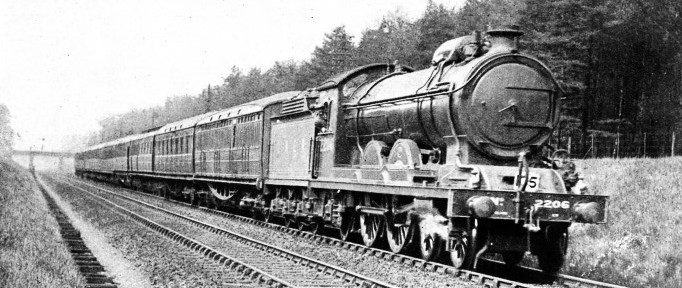
AN “ATLANTIC” EXPRESS ENGINE, formerly of the North Eastern Railway, hauling an LNER train near Barkston, Lincolnshire. Designed in 1911, these three-cylinder locomotives have 16½ in by 26 in cylinders, and a total heating surface, including superheater, of 2005.8 sq ft. The boiler pressure is 160 lb, and the engine alone weighs, in working order, 77 tons 2 cwt. The apparatus above the boiler is a feed-water heater.
Four-cylinder engines were also built in large numbers during this period, for the Great Western, London and North Western, London and South Western, and Lancashire and Yorkshire Railways. Cylinder bores of these four-cylinder types varied between 14¼ in to 16½ in diameter and stroke between 26 and 30 in. Driving wheels ranged from 6 ft to 6 ft 9 in diameter.
In 1917 J. G. Robinson introduced some powerful 4-6-0 engines on the Great Central Railway. These had four cylinders with inside link motion driving all four valves by arms on rocking shafts. R. W. Urie’s 4-6-0 engines of the London and South Western Railway had 22 in by 28 in cylinders and 6 ft 7 in driving wheels. These engines weighed 77 tons 17 cwt.
A large number of powerful tank engines were built just before and during the war of 1914-18, and these have been described in the chapter on “Tank Engines”. Many goods engines of this period were built with the 2-6-0 and 4-6-0 wheel arrangement, replacing the 0-6-0 type for fast freight traffic. For ordinary goods traffic the 0-6-0 engine was retained, and fine examples of the type are the superheated Midland engines designed by Sir H. Fowler in 1911. These have 20 in by 26 in cylinders, 5 ft 3 in wheels, and weigh 49 tons 2 cwt.
ln the Twentieth Century
A number of 2-6-0 engines were built for the Caledonian Railway in 1912, and also for the Glasgow and South Western Railway between 1901 and 1905.
Between 1911 and 1918 J. G. Robinson designed a class of heavy 2-8-0 goods engines for the Great Central Railway. These have 21 in by 26 in outside cylinders driving on to the third pair of coupled wheels, which are of 4 ft 8 in diameter. Piston valves between the frames are operated by Stephenson’s link motion. The weight of the engine is 73 tons 17 cwt.
At the time these engines were designed it could not have been foreseen that they would play an important part in the war of 1914-18. During the war, however, no fewer than 521 of these locomotives were built at Britain’s leading engine works for the Government. They were adopted as standard for working heavy goods and troop trains, both in Britain and over-seas. After the war, these engines were sold in large numbers to various British railways.
In 1917 R. E. Maunsell built some powerful 2-6-0 goods engines for the South Eastern and Chatham Railway, with outside cylinders 19 in by 28 in, and driving wheels 5 ft 6 in. Their weight was 59 tons 8 cwt.
Some large six-coupled goods locomotives were built for the Great Eastern and Great Northern (Ireland) Railways in 1920. The Great Eastern engines, designed by A. J. Hill, have 20 in by 28 in. inside cylinders and 4 ft 11 in driving wheels. The Irish locomotives, designed by G. T. Glover, have cylinders 19½ in by 26 in, with 5 ft 1 in driving wheels.
A large number of 4-6-0 goods and mixed traffic engines were built during the period 1919-21 for the London and South Western, North Eastern, and Great Central Railways. The Great Central engines, designed by J. G. Robinson, have four cylinders, 16 in by 26 in, and 5 ft 8 in driving wheels.
In 1925 H. N. Gresley designed a 2-8-2 mineral locomotive with three cylinders 20 in by 26 in, and 5 ft 2 in driving wheels.
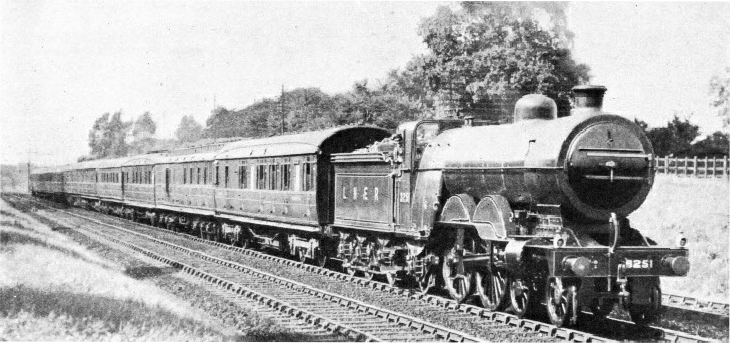
NINETY-THREE OF THESE “ATLANTIC” TYPE ENGINES were built by H. A. lvatt for the Great Northern Railway. The last of the series was put into service in 1910. The engines have cylinders 20 in by 24 in, coupled wheels 6 ft 7½ in diameter, a boiler pressure of 180 lb per sq in and a total heating surface of 2,022 sq ft. For twenty years they were the standard express engines of the Great Northern Railway. Though now superseded on the heaviest duties by the “Pacifics”, they still work many important trains such as the “Queen of Scots” Pullman.
You can read more on “The Story of the Locomotive”, “The Story of the Locomotive - 2”, “The Story of the Locomotive - 3” and “Tank Engines” on this website.











